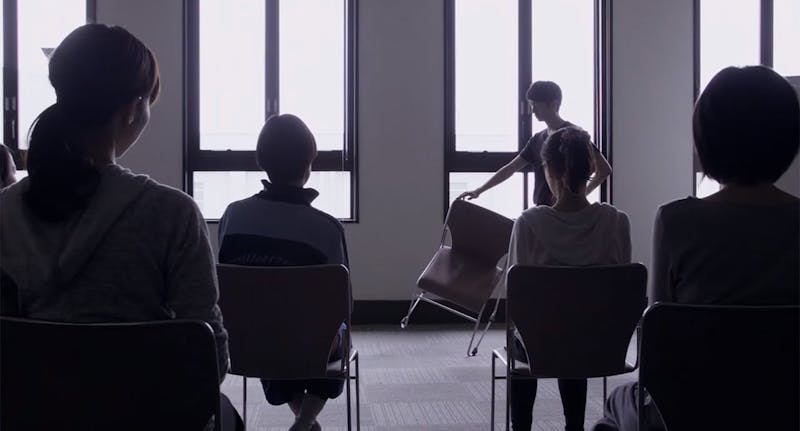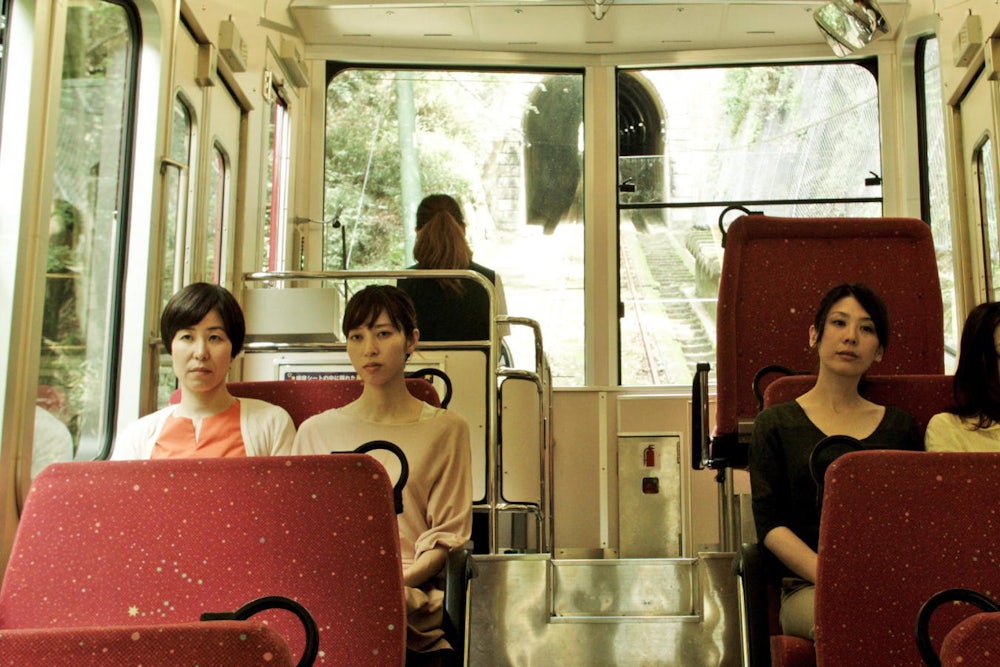It sounded a bit like torture. The sheer length of Happy Hour, the new film by Japanese director Ryusuke Hamaguchi that screened this past week at the Museum of Modern Art, was daunting: five and half hours! And these were not five and a half hours—317 minutes to be precise—that would fly by in frenetic spectacle. No, they would plod along, dwelling on the banal details of the intersecting lives of four women in Kobe.
But when I watched the trailer, a wordless 90 seconds of scenes spliced from the movie, I knew that I would have to see it. A woman’s head turns to blow out cigarette smoke; a train emerges from a tunnel, gradually illuminating the faces within the carriage’s interior; a ferry leaves the harbor in such a way that it looked as if the world, not the boat, is gliding across the screen. And I wanted five and a half hours—not two, not three—of that.
We live in a golden era for those who love their art mired in monotony. Karl Ove Knausgaard’s My Struggle, one of the most celebrated novels of recent years, is a 3,000-page account of one man’s life told in microscopic detail. Nobel laureate Svetlana Alexievich’s Secondhand Time is an enormous compilation of firsthand accounts of the collapse of the Soviet Union, packed with stories that range from the extraordinary to the tedious. Netflix recently began streaming “slow TV,” a Scandinavian export wherein humdrum activities—train travel, knitting, driving a car, choral singing—are filmed for hours on end. Even familiar forms have been warped and stretched to the limit, to better allow their audiences to wallow in the subject matter. To qualify for an Academy Award, the epic documentary O.J.: Made in America, clocking in at 7 hours and 44 minutes, had a short run in theaters, leading The Los Angeles Times to ask, is this a show or a movie?
Unlike most binge entertainments, Happy Hour doesn’t seek to divert our attention from everyday life, but to focus on it intently—to such an extent that it begins to rival life itself. The film is so long that it’s difficult to pinpoint what it’s about precisely, as if its center of gravity has been lost amidst so much sprawl. On one level, it is about how Japanese society remains corrosively divided by gender, age, and circumstance. The women are consigned to lives of thankless home-making, while the men are married to their jobs. An aging population takes a psychological toll on the young, and emotional fissures have opened up in the wake of natural disasters. But above all, Happy Hour is about how we are mysteries to those closest to us, as well as to ourselves. These essential themes bubble up from the depths but also seem to float right at the film’s surface, a testament to the richness of Hamaguchi’s pellucid style. Watching Happy Hour is like peering into a limpid lake: You can see all the way down to the bottom.
These themes also could have found their expression in a movie half the length—and this would have been a very good movie. Where Happy Hour gets stretched is in a handful of set pieces that play out in virtual real-time: a New Age-y therapy session orchestrated by an enigmatic artist; a reading of a short story conducted by a diminutive woman in a flat, affectless voice; a conversation over drinks, a conversation over coffee, then another conversation over drinks. These passages are so “real,” so stiflingly trapped in time, that I wanted to reach through the screen and have a beer myself, to make the seconds pass a little quicker. But as I continued to watch, reality began to show its cracks, breaking apart to reveal glimmering abstractions. During the therapy session, the participants divide into pairs and touch foreheads to communicate telepathically. They put their ears on their partners’ bellies, to listen to “the sound of your guts.” They circle each other, orbiting a void. They are so close, yet so far.
Then there are the moments when the camera lingers on images that may not mean anything in and of themselves—trains passing in the night, reflected trees slipping off a car windshield, blood drawn from a vein—but taken together, they do amount to something of a credo for Hamaguchi. He spells it out in the scene with the short story, a Knausgaard-esque exercise in quotidian realism that is read nearly in its entirety. One member of the audience praises the author for showing “the world as it is,” since it made him love it all the more.
The world as it is—why would this be so desirable in art, when the world is the medium in which we live and breathe? You could argue that it all goes back to our modern way of life, that our hunger for the real stems from the increasing amount of time we spend away from it, opting instead to plunge into virtual worlds and to commune with our digital peers. As someone who spends his entire workday chained to computer screens of various sizes, jacked into Twitter like those poor souls in The Matrix, there is some appeal to this argument. Maybe the desire to commit myself to a single, excruciatingly slow movie for five and a half hours is a way to atone for the fact that my attention span has become as twitchy as a squirrel’s. Maybe watching everyday activities—knitting, singing, divorcing your emotionally estranged Japanese husband—has become “a kind of self-satisfied cultural homework,” as my co-worker put it, “like deciding to read Moby-Dick or something.”

But that doesn’t fully explain the appeal of art that mimics the ebb and flow of the ordinary. “Art is the nearest thing to life,” wrote George Eliot. She was discussing art’s superior ability to rouse our sympathies for other people, to provide the “raw material of moral sentiment” that mere argument or scientific evidence cannot. But she also touched on an aspect of art that is pertinent to Hamaguchi’s work, declaring that the artist enlightens “by giving us his higher sensibility as a medium, a delicate acoustic or optical instrument, bringing home to our coarser senses what would otherwise be unperceived by us.”
I would argue that what goes unperceived by us is almost everything. Art is the true repository of what we consider real, not this other reality in which we swim obliviously like fish in a tank. In Happy Hour, and particularly in that beautiful scene on the ferry, the world is not just gliding by—it is being slid into place before our eyes, as if for the first time.
The Soviets had an excellent phrase—“kitchen talk”—for the intimate conversations in which they could discuss their lives freely, away from the prying eyes of the state. Svetlana Alexievich is in many ways the Nobel laureate of kitchen talk, largely sharing Hamaguchi’s view of the relationship between art and reality. Secondhand Time is based on dozens of interviews that have been massaged and embellished to create a symphonic pseudo–oral history of the Soviet Union’s demise, a moment of liberation that turned out to be one of the great catastrophes of the twentieth century. But her work is also a chronicle of monotony; of everyday life under communism, Gorbachev’s perestroika, and the disastrous “shock therapy” capitalism of the 1990s.
It is hard to think of a book of recent vintage that has come as close to the raw material Eliot spoke of. That is the source of its strange power: It comes from the mouths, more or less, of ordinary people. Alexievich writes of one interview:
I didn’t realize right away that I should turn on the tape recorder so as not to miss this transformation of life—everyday life—into literature. I’m always listening for it, in every conversation, both general and private. Occasionally, my vigilance flags—a “fragment of literature” may sparkle into sight at any moment, even in the most unexpected places.
Alexievich goes a little further than simply rendering life “as it is.” She sees life as fodder for her books, judging moments by whether they can be fixed in the realm of art. Admittedly, this is a rather perverse way of looking at the world. We do not gaze upon our children and cry, “Ah, my precious fragment of literature!” But on the other hand, Alexievich, Hamaguchi, and other artists of similar bent stand against a far more perverse and pervasive view: that which would look on the mundane and discern no value at all.
